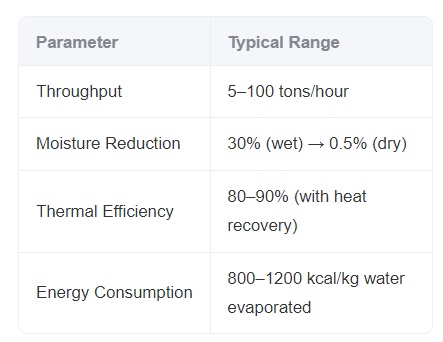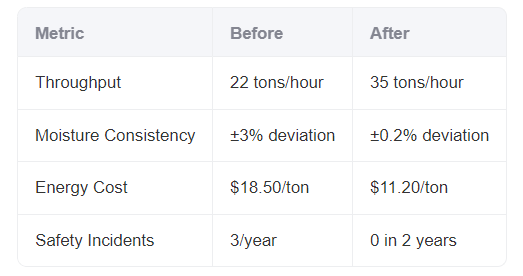Rotary drum dryers are thermal processing systems designed to reduce moisture content in bulk materials through controlled heat transfer and mechanical agitation. Let’s dissect their engineering:
Core Components
Rotating Drum:
Dimensions: Typically 2-5m in diameter, 10-30m long (e.g., Φ3.2×22m for silica sand).
Slope & Speed: 1-5° inclination with 2-8 RPM rotation for adjustable residence time.
Heat Source:
Direct heating (gas burners at 800-1200°C) or indirect (thermal oil at 300°C).
Material Handling:
Feed System: Screw conveyors with pre-drying cyclones to separate fines.
Lifter Plates: Stainless steel lifters cascade materials for 360° exposure.
Performance Metrics

Case Study: Solving Gypsum Drying Challenges for Desert Minerals Co., Saudi Arabia
Industry: Building materials manufacturing.
Material: Natural gypsum (calcium sulfate dihydrate).
Production Goal: 300,000 tons/year of anhydrous gypsum for wallboard.
Initial Challenges
Inconsistent Drying: Moisture fluctuated between 1.5–5% due to uneven heat distribution.
Energy Waste: LPG consumption reached 15 m³/ton, exceeding budget by 40%.
Dust Explosion Risks: Fine gypsum particles ignited at 480°C, requiring ATEX-certified safety systems.
Engineering Solution
We designed a Φ4.2×24m Indirect Rotary Dryer with these innovations:
1. Segmented Heating Zones
Zone 1 (Pre-Drying): 180°C thermal oil to reduce moisture from 12% → 6%.
Zone 2 (Final Drying): 250°C oil for final dehydration to 0.3%.
2. Closed-Loop Heat Recovery
Captured exhaust heat (120°C) to preheat incoming air, cutting LPG use by 28%.
3. Explosion Prevention System
Nitrogen inertization to maintain O₂ < 8% in the drum.
Spark detection sensors with automatic shutdown.
Operational Results

Client Testimonial
“The customized rotary dryer eliminated production bottlenecks. We now export gypsum to 15 countries with zero quality rejections.”
– Ahmed Al-Farsi, Production Director, Desert Minerals Co.
Applications Across Industries
1. Mining & Minerals
Bauxite Drying: Prepares ore for Bayer process (moisture <1%).
Kaolin Clay: Reduces moisture from 18% → 2% for ceramic glazes.
2. Agriculture
Animal Feed: Dries DDGS (distillers' grains) from 65% → 10% moisture.
Fertilizers: Processes NPK granules without nutrient degradation.
3. Waste Recycling
Sewage Sludge: Converts 80% moisture sludge into biomass fuel (15% moisture).
Top 5 Maintenance Strategies for Peak Performance
Daily Checks:
Inspect gearbox oil levels (ISO VG 320 recommended).
Monitor belt tension (deflection <10mm per 1m span).
Monthly Tasks:
Laser-align drum rollers (tolerance ±0.5mm/m).
Clean heat exchanger fins to maintain 85% efficiency.
Annual Overhaul:
Replace lifters and seals.
Recalibrate temperature sensors (accuracy ±1°C).
FAQ: Answering Key Customer Questions
Q1: Can rotary dryers handle sticky materials like clay?
Yes. Our design integrates anti-adhesion solutions:
Drum Coatings: Teflon or ceramic coatings prevent buildup.
Chain Slappers: Rotating chains dislodge sticky materials.
Q2: What’s the ROI timeline for a $500k rotary dryer?
Typical payback period:
High-Volume Operations: 1.5–2 years (e.g., 100 tons/hour sand drying).
Niche Applications: 3–4 years (e.g., specialty chemical drying).
Why Choose Our Rotary Dryers?
Proven Designs: 120+ installations in 30 countries (ISO 9001 certified).
Smart Drying™ Technology: IoT-enabled controls optimize temperature and RPM in real-time.
Lifetime Support: Remote diagnostics and 48-hour spare parts delivery.